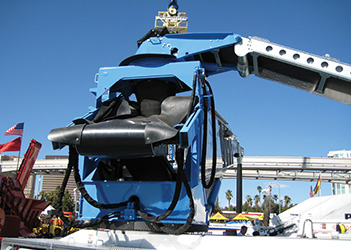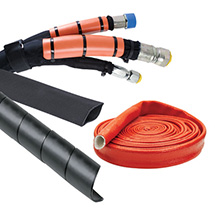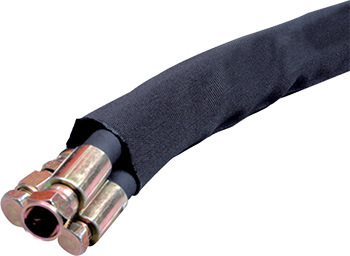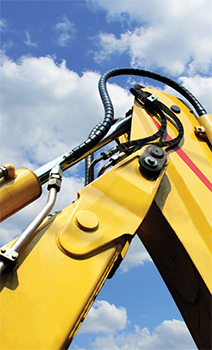
During the course of everyday operations, hydraulic hose assemblies are exposed to moisture, dirt, corrosion, high temperatures and physical impact. Continuous movement and rubbing against other hoses or equipment—often caused by machine vibrations—can erode hose covers, while non-compatible fluids can eat away at them as well. And once this outer layer of protection is gone, hose reinforcement is open to even more damage and rust. Thus, it is essential that necessary precautions be taken to protect them.
Hose protection products, such as sleeves and wraps, can be simple to use. They protect against cuts, abrasions and ultraviolet rays and resist crushing. And not only do these simple devices save hose, they help to reduce the risk of industrial injuries to employees or damage to integral hose assemblies by preventing hose ruptures in the field.

Hose protection sleeves
Hose sleeves are the last line of defense in protecting people, environment and machinery against hose bursts or leakage. They also protect hose against abrasion.
Quick assemble hose or cable protective sleeves are suitable for use in the field or for applications where the winding of spiral-formed products is difficult. Resistant to heat, ozone and abrasion, these sleeves contain hoses to protect operators from hose failures in close quarters. A special Python hook-and-loop design closure promotes quick and easy bundling of hose groupings; it is easy to assemble or remove.
Essentra’s line of mining safety-approved sleeves protects against any possible hydraulic hose oil leakage, ruptures or spills. Its polyamide material means this sleeve is dense, yet not bulky, and still provides a high degree of burst resistance and abrasion protection. Effective in reducing the concentrated stream of pinhole leaks, which can be a huge but less noticeable danger, this sleeve provides excellent leakage containment. Tested and approved by M.S.H.A. (approval #M.S.H.A. IC-234/0), this mining safety-approved sleeve meets FED-STD-191 test method 5309 for abrasion resistance and ASTM D6770 for abrasion resistance of textile webbing.
A full line of fire protection sleeves has excellent elasticity for protecting or bundling hoses, tubes and cables in a variety of hostile environments. The insulation properties of the outer silicone rubber and inner knitted glass fiber provide close quartered personnel with effective protection against burns from hot hoses and reduced heat energy loss. This sleeve withstands intense radiant heat and flame of continuous exposure up to 500° F (260° C), 15 to 20 min up to 2,000° F (1090° C), and 5 to 30 sec up to 3,000° F (1,650° C). Furthermore, it can withstand repeated exposures to molten steel, molten aluminum and molten glass up to 3,000° F (1,650° C).

Additionally, hose sleeving allows for easy bundling of hose that flexes in the same direction. For safety’s sake, users should only bundle hoses of the same designs and pressure rating, so only high-pressure hose in one sleeve, while low-pressure designs should be bundled in another. Also, take care to not bundle hoses too tightly and to give a proper amount of slack so fittings and hoses will not be stretched beyond their limits. (An added benefit of hose sleeves is aesthetics, as they provide a more streamlined look to hydraulic hose on machinery.)
Hose protection wraps
Hose covers are offered in a variety of styles, such as wire or flat armor spring, nylon sleeves or plastic coil sleeving. They protect against abrasion and crushing, thus extending hose life.
Essentra’s Spiralguard is suitable for hydraulic, pneumatic and industrial hose assemblies. It is radial cut from extruded tube, enabling high natural recovery memory and flexibility to maximize hose coverage. Manufactured in a high-density polyethylene material, Spiralguard has high abrasion resistance, anti-crushing performance and resistance to UV deterioration. This material is also a thinner, lightweight product, but still maintains industrial strength and quality. Featuring a heavy–duty, double-beveled edge design to prevent snagging and cutting during installation, it is easy and safe to install before or after the hose assembly is mounted. A medium-duty product is available for use on applications where abrasion is not frequent, but protection is still needed.

For mining and quarrying applications, users might consider a mine-safety-approved, flame-retardant and antistatic series of Spiralguard that protects underground hose assemblies. Tested and approved by Mine Safety Laboratory, Department of Mineral Resources NSW to AS2660 FRAS Compliance (1991 International Standard: ISO6805) and in accordance with the former British Coal specification 182:1986, this line satisfies the requirements of the non-metallics scheme for use underground.
A lightweight and flexible Cellulose Acetate option is still crush resistant, but its lightweight profile will cover much more hose surface during a flexing or bending process than any other wrap. The inner core ensures flexibility, while the external profile ensures resistance to abrasion, crushing and electrical conductivity.
If weight and size are an issue, but some hose still needs protection, you could consider point-of-contact protectors. These are a more economical solution when there are few single sources of hose wear. Made out of PVC, these are durable and have a high wear factor. Point-of-contact protectors are easy to assemble and remove as they are simply assembled with a cable tie. They are used mostly on hydraulic hoses, fuel and oil lines, brake systems, wiring harnesses and battery cables, and can be used in conjunction with hose protection sleeves.
Essentra Components
us.essentracomponents.com

For further hose protection and safety, check out IFPS’ Connector and Conductor certification.
http://www.ifps.org/docs/certification/certifications_offered/fluid_power_conductor_connector/default.aspx